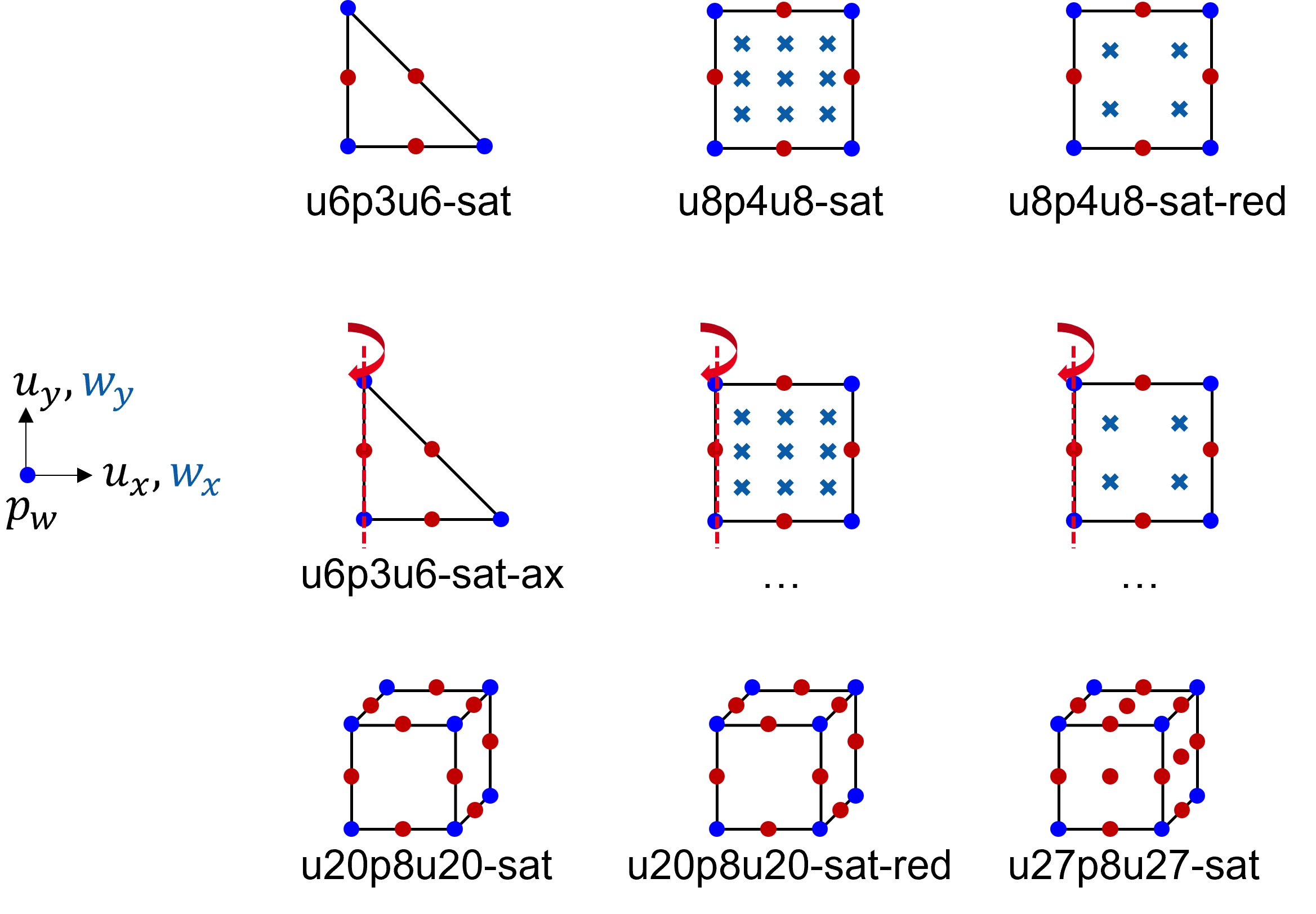Two-phase porous solid elements with water displacement and pore water pressure dof (u-p-U elements)

Similar to the u-p elements, these elements are implemented for simulating the response of a two-phase solid-fluid fully coupled material, based on Biot's theory of porous medium:
- The porous medium is composed of one solid phase (e.g. soil skeleton) and one pore-fluid (e.g. water) and is assumed to be always saturated.
-
Each node has 5 (7 in 3D) degrees of freedom:
- solid displacements \(u_1\) and \(u_2\) (and \(u_3\) in 3D)
- pore-fluid pressure \(p^w\)
- water displacements \(w_1\) and \(w_2\) (and \(w_3\) in 3D)
-
The prescribed densities are the density of the solid grains \(\rho^s\) and the pore fluid \(\rho^w\). The density of the continuum \(\rho\) is calculated based on the assigned porosity \(n\) (or void ratio)
$$ \rho = (1-n) \cdot \rho^s + n \cdot \rho^w $$
2D Elements
| Element label | Dim. | Shape | Nodes | Interpolation Order | nIP* | Remarks |
|---|---|---|---|---|---|---|
u6p3u6-sat |
2D | triangle | 6 | quadratic | 3 | (1), (2) |
u8p4u8-sat |
2D | rectangle | 8 | quadratic | 9 | (1), (2) |
u8p4u8-sat-red |
2D | rectangle | 8 | quadratic | 4 | (2), (3) |
Axisymmetric Elements
| Element label | Dim. | Shape | Nodes | Interpolation Order | nIP* | Remarks |
|---|---|---|---|---|---|---|
u6p3u6-sat-ax |
axisym. | triangle | 6 | quadratic | 3 | (1), (2) |
u8p4u8-sat-ax |
axisym. | rectangle | 8 | quadratic | 9 | (1), (2) |
u8p4u8-sat-ax-red |
axisym. | rectangle | 8 | quadratic | 4 | (2), (3) |
3D Elements
| Element label | Dim. | Shape | Nodes | Interpolation Order | nIP* | Remarks |
|---|---|---|---|---|---|---|
u20p8u20-sat |
3D | brick | 20 | quadratic | 27 | (1), (2), (4) |
u20p8u20-sat-red |
3D | brick | 20 | quadratic | 8 | (2), (3), (4) |
u27p8u27-sat |
3D | brick | 27 | quadratic | 27 | (1), (2) |
Remarks
| * | nIP = number of integration points |
|---|---|
| (1) | Due to the full integration, the element will behave badly for isochoric material behavior. This shortcoming is more pronounced for linear interpolated elements and less pronounced for quadratic interpolated ones. |
| (2) | Taylor-Hood formulation: The solid and water displacements are interpolated using quadratic shape functions, whereas the pore-fluid pressure \(p^w\) is interpolated using linear shape functions. |
| (3) | Reduced integration: This element does not suffer from the same locking issues as fully integrated elements. |
| (4) | 3D-serendipity elements such as the element are not suitable for contact analysis. The option bi-quadratic can be used automatically transform u20p8u20 to u27p8u27 elements. |
Notice that these elements require the definition of a two-phase material: (*Material,..., Phases=2) as described in *Material.